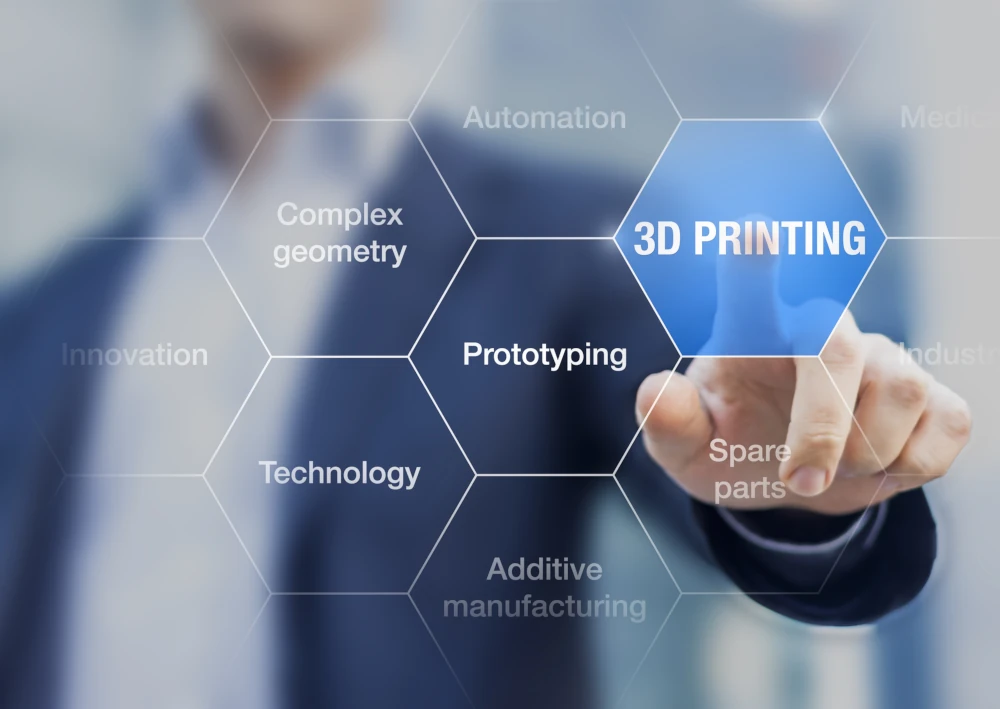
7 Things You Should Know About Metal 3D Printing
Metal additive manufacturing is a process that continues to evolve every day. As technology advances, it takes on new capabilities and applications engineers once thought impossible.
This is why it never hurts to ask questions about the process -- your perception may not meet today’s reality. Whether you’re coming from forging or traditional powder metal or another world, this metal additive manufacturing FAQ can help inform your next design decision:
Metal Additive Manufacturing FAQ
Below are seven frequently asked questions about metal additive manufacturing (also known as metal AM):
- What is metal additive manufacturing?
- How does metal additive manufacturing work?
- What are the advantages of metal additive manufacturing?
- Are there variations on the process, or is it one-size-fits-all?
- Is metal additive manufacturing expensive?
- Is injection molding the same as additive manufacturing?
- What is subtractive manufacturing?
What Is Metal Additive Manufacturing?
Metal additive manufacturing is the process in which metal powders are layered together to create strong and complex-shaped components.
Metal additive manufacturing is also known as metal 3D printing.
How Does Metal 3D Printing Work?
The way that metal additive manufacturing works will depend on the technique your manufacturer uses.
For example, if we were using the binder jet 3D printing process, we could break the technique down into five simple steps:
Step 1: Metal powder is deposited along the printing platform.
Step 2: An inkjet goes over the platform, applying a liquid binder to select parts of the powder.
Step 3: Another layer of powder is placed across the binder.
Step 4: The inkjet goes over the platform again, adding a binder to the same areas.
Step 5: The process repeats itself until the component is complete.
Other AM technologies have different ways of creating the same component, but binder jet technology is the ideal option for high-volume orders.
What Are the Advantages of Metal Additive Manufacturing?
There are several reasons why metal additive manufacturing is viable in a variety of applications. It’s most popular for its deft handling of varying production volumes, rare shape-making capabilities, and lower price points compared to other metal manufacturing technologies.
Metal additive manufacturing has several other advantages over manufacturing technologies, such as:
- The ability to produce complex components
- The ability to produce durable and lightweight components
- Increased efficiency
Complex Components
The ability to produce complex components is typically accompanied by high costs, tooling creation, and long wait times. Additive manufacturing takes these factors out of the equation.
With traditional manufacturing techniques, engineers need to find a way to remove or “hollow out” any parts that aren’t intended to be solid. However, with additive manufacturing, this temporary “filler” is unnecessary.
The more complex and less dense the design is, the cheaper it will be due to it requiring less material.
Durable & Lightweight Components
Your product’s total weight plays a big role in the amount you spend on material and lead time because heavier weights mean more material. This is especially true when ordering a mass quantity of certain components.
Metal additive manufacturing is capable of producing lightweight components that maintain their durability and ability to function as needed. This means you can produce an equally sturdy design with less material -- and therefore less weight.
Increased Efficiency
Since nothing will need to be removed from your component (other than any temporary support structures needed for production), there’s no need for secondary operations. This significantly cuts back on the amount of time you have to wait for an order.
Metal additive manufacturing excels at both low-volume prototype orders and mass production.
Are There Different Metal Additive Manufacturing Technologies?
Yes, there are several different metal additive manufacturing technologies in use today. Some of the most popular include:
- Binder jetting
- Electron beam melting (EBM)
- Selective laser melting (SLM)
- Direct metal laser sintering (DMLS)
Is Metal Additive Manufacturing Expensive?
Although the initial investments in machinery and software are expensive, the actual metal additive manufacturing process is not. This is why many OEM sellers outsource their metal AM needs.
Most projects cost less with metal AM compared to other manufacturing processes due to the reduced amount of scrap waste produced. This, combined with fast turnaround times and intricate quality, makes metal additive manufacturing one of the most cost-effective and successful production methods.
Is Injection Molding the Same as Additive Manufacturing?
No, injection molding manufacturing (MIM) isn’t the same. However, they both have their own advantages when it comes to certain phases of prototype production.
Injection molding melts a material and injects it using a cavity inside of a steel tool. On the contrary, metal additive manufacturing binds together layers of metal powder until it achieves a finished product. It’s the better option for rapid prototyping due to its lower cost and ability to print consistent components.
What is Subtractive Manufacturing?
Subtractive manufacturing is, as the name suggests, the direct opposite of additive manufacturing. Machining is a classic example.
CNC machining starts with a block of selected material, then removes parts of it using computer technology to achieve a finished component.
Subtractive manufacturing is great for making extremely sturdy components, but its cost tends to run much higher than additive manufacturing, particularly due to the amount of waste it creates.
Have Any More Questions?
Additive manufacturing is a great option for those looking for specific capabilities in medical, automotive, and even aerospace applications. Its uses are expanding by the day, so what you thought was impossible or ineffective with AM may be quite the opposite.
